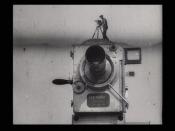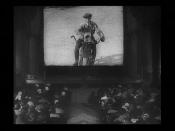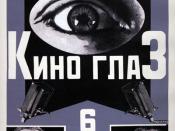"Man with a Movie Camera" (Dziga Vertov, 1929), is a self confessed cinematic experiment. It is a film without actors or plot, its intention is to attempt to create a "truly international, absolute language of cinema based on its total separation from the language of theater and literature." Vertov creates a film that would be considered highly experimental and original now, let alone in 1929. The film consists of a wealth of images edited together in a fashion that may appear somewhat random on a first viewing, but holds a number of hidden messages and links. In the film many parallels are made, for example by editing together images of shutter blinds alongside footage of rapidly blinking eyes.
MWAMC came across to me as a euphoric and exciting celebration of Russian society and technology (including film-making itself) circa 1929. However one of the main intentions of the film is that the audience is left to derive it's own meaning from the images.
And not spoon-feed it's meaning like the more common formulaic breed of movie. I believe that MWAMC shows us that there is a definite link between technology and culture. In this essay I aim to explore these links.
According to "www.Dictionary.com" the relevant definition of culture can be expressed as the following:
1: A particular civilization at a particular stage
2: The tastes in art and manners that are favored by a social group
3: All the knowledge and values shared by a society
This definition firstly refers to culture as a civilization at a certain stage in their development. When we think about what makes our society different from that of one of five hundred years ago, one of the main differences that spring to mind is a change in culture. Which when broken...


